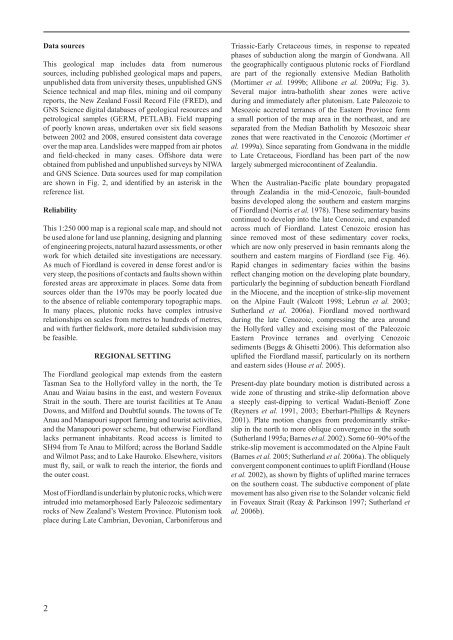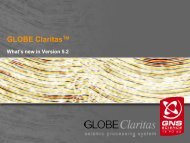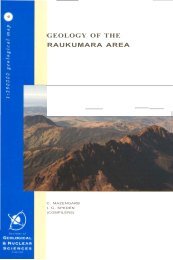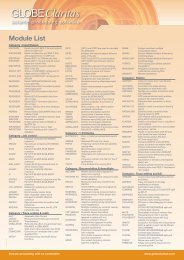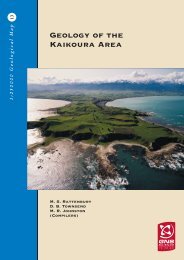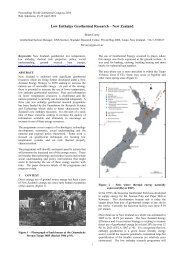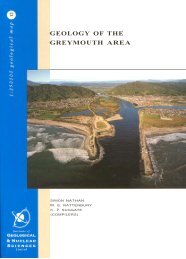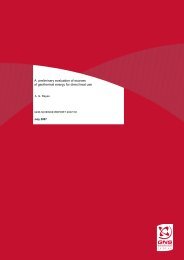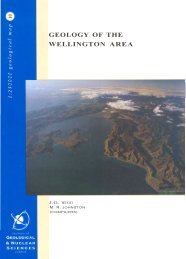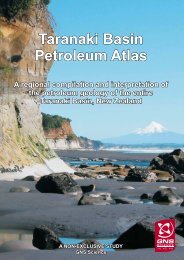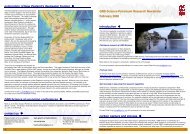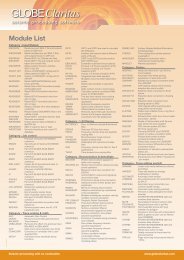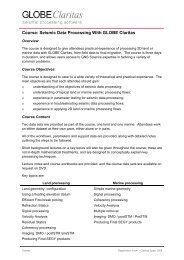Geology of the Fiordland Area - GNS Science
Geology of the Fiordland Area - GNS Science
Geology of the Fiordland Area - GNS Science
- No tags were found...
You also want an ePaper? Increase the reach of your titles
YUMPU automatically turns print PDFs into web optimized ePapers that Google loves.
Data sourcesThis geological map includes data from numeroussources, including published geological maps and papers,unpublished data from university <strong>the</strong>ses, unpublished <strong>GNS</strong><strong>Science</strong> technical and map files, mining and oil companyreports, <strong>the</strong> New Zealand Fossil Record File (FRED), and<strong>GNS</strong> <strong>Science</strong> digital databases <strong>of</strong> geological resources andpetrological samples (GERM, PETLAB). Field mapping<strong>of</strong> poorly known areas, undertaken over six field seasonsbetween 2002 and 2008, ensured consistent data coverageover <strong>the</strong> map area. Landslides were mapped from air photosand field-checked in many cases. Offshore data wereobtained from published and unpublished surveys by NIWAand <strong>GNS</strong> <strong>Science</strong>. Data sources used for map compilationare shown in Fig. 2, and identified by an asterisk in <strong>the</strong>reference list.ReliabilityThis 1:250 000 map is a regional scale map, and should notbe used alone for land use planning, designing and planning<strong>of</strong> engineering projects, natural hazard assessments, or o<strong>the</strong>rwork for which detailed site investigations are necessary.As much <strong>of</strong> <strong>Fiordland</strong> is covered in dense forest and/or isvery steep, <strong>the</strong> positions <strong>of</strong> contacts and faults shown withinforested areas are approximate in places. Some data fromsources older than <strong>the</strong> 1970s may be poorly located dueto <strong>the</strong> absence <strong>of</strong> reliable contemporary topographic maps.In many places, plutonic rocks have complex intrusiverelationships on scales from metres to hundreds <strong>of</strong> metres,and with fur<strong>the</strong>r fieldwork, more detailed subdivision maybe feasible.REGIONAL SETTINGThe <strong>Fiordland</strong> geological map extends from <strong>the</strong> easternTasman Sea to <strong>the</strong> Hollyford valley in <strong>the</strong> north, <strong>the</strong> TeAnau and Waiau basins in <strong>the</strong> east, and western FoveauxStrait in <strong>the</strong> south. There are tourist facilities at Te AnauDowns, and Milford and Doubtful sounds. The towns <strong>of</strong> TeAnau and Manapouri support farming and tourist activities,and <strong>the</strong> Manapouri power scheme, but o<strong>the</strong>rwise <strong>Fiordland</strong>lacks permanent inhabitants. Road access is limited toSH94 from Te Anau to Milford; across <strong>the</strong> Borland Saddleand Wilmot Pass; and to Lake Hauroko. Elsewhere, visitorsmust fly, sail, or walk to reach <strong>the</strong> interior, <strong>the</strong> fiords and<strong>the</strong> outer coast.Most <strong>of</strong> <strong>Fiordland</strong> is underlain by plutonic rocks, which wereintruded into metamorphosed Early Paleozoic sedimentaryrocks <strong>of</strong> New Zealand’s Western Province. Plutonism tookplace during Late Cambrian, Devonian, Carboniferous andTriassic-Early Cretaceous times, in response to repeatedphases <strong>of</strong> subduction along <strong>the</strong> margin <strong>of</strong> Gondwana. All<strong>the</strong> geographically contiguous plutonic rocks <strong>of</strong> <strong>Fiordland</strong>are part <strong>of</strong> <strong>the</strong> regionally extensive Median Batholith(Mortimer et al. 1999b; Allibone et al. 2009a; Fig. 3).Several major intra-batholith shear zones were activeduring and immediately after plutonism. Late Paleozoic toMesozoic accreted terranes <strong>of</strong> <strong>the</strong> Eastern Province forma small portion <strong>of</strong> <strong>the</strong> map area in <strong>the</strong> nor<strong>the</strong>ast, and areseparated from <strong>the</strong> Median Batholith by Mesozoic shearzones that were reactivated in <strong>the</strong> Cenozoic (Mortimer etal. 1999a). Since separating from Gondwana in <strong>the</strong> middleto Late Cretaceous, <strong>Fiordland</strong> has been part <strong>of</strong> <strong>the</strong> nowlargely submerged microcontinent <strong>of</strong> Zealandia.When <strong>the</strong> Australian-Pacific plate boundary propagatedthrough Zealandia in <strong>the</strong> mid-Cenozoic, fault-boundedbasins developed along <strong>the</strong> sou<strong>the</strong>rn and eastern margins<strong>of</strong> <strong>Fiordland</strong> (Norris et al. 1978). These sedimentary basinscontinued to develop into <strong>the</strong> late Cenozoic, and expandedacross much <strong>of</strong> <strong>Fiordland</strong>. Latest Cenozoic erosion hassince removed most <strong>of</strong> <strong>the</strong>se sedimentary cover rocks,which are now only preserved in basin remnants along <strong>the</strong>sou<strong>the</strong>rn and eastern margins <strong>of</strong> <strong>Fiordland</strong> (see Fig. 46).Rapid changes in sedimentary facies within <strong>the</strong> basinsreflect changing motion on <strong>the</strong> developing plate boundary,particularly <strong>the</strong> beginning <strong>of</strong> subduction beneath <strong>Fiordland</strong>in <strong>the</strong> Miocene, and <strong>the</strong> inception <strong>of</strong> strike-slip movementon <strong>the</strong> Alpine Fault (Walcott 1998; Lebrun et al. 2003;Su<strong>the</strong>rland et al. 2006a). <strong>Fiordland</strong> moved northwardduring <strong>the</strong> late Cenozoic, compressing <strong>the</strong> area around<strong>the</strong> Hollyford valley and excising most <strong>of</strong> <strong>the</strong> PaleozoicEastern Province terranes and overlying Cenozoicsediments (Beggs & Ghisetti 2006). This deformation alsouplifted <strong>the</strong> <strong>Fiordland</strong> massif, particularly on its nor<strong>the</strong>rnand eastern sides (House et al. 2005).Present-day plate boundary motion is distributed across awide zone <strong>of</strong> thrusting and strike-slip deformation abovea steeply east-dipping to vertical Wadati-Beni<strong>of</strong>f Zone(Reyners et al. 1991, 2003; Eberhart-Phillips & Reyners2001). Plate motion changes from predominantly strikeslipin <strong>the</strong> north to more oblique convergence in <strong>the</strong> south(Su<strong>the</strong>rland 1995a; Barnes et al. 2002). Some 60–90% <strong>of</strong> <strong>the</strong>strike-slip movement is accommodated on <strong>the</strong> Alpine Fault(Barnes et al. 2005; Su<strong>the</strong>rland et al. 2006a). The obliquelyconvergent component continues to uplift <strong>Fiordland</strong> (Houseet al. 2002), as shown by flights <strong>of</strong> uplifted marine terraceson <strong>the</strong> sou<strong>the</strong>rn coast. The subductive component <strong>of</strong> platemovement has also given rise to <strong>the</strong> Solander volcanic fieldin Foveaux Strait (Reay & Parkinson 1997; Su<strong>the</strong>rland etal. 2006b).2


